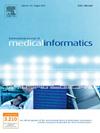The feasibility of using machine learning to predict COVID-19 cases
IF 3.7
2区 医学
Q2 COMPUTER SCIENCE, INFORMATION SYSTEMS
International Journal of Medical Informatics
Pub Date : 2025-01-23
DOI:10.1016/j.ijmedinf.2025.105786
引用次数: 0
Abstract
Background
Coronavirus Disease 2019 (COVID-19), caused by the SARS-CoV-2 virus, emerged as a global health crisis in 2019, resulting in widespread morbidity and mortality. A persistent challenge during the pandemic has been the accuracy of reported epidemic data, particularly in underdeveloped regions with limited access to COVID-19 test kits and healthcare infrastructure. In the post-COVID era, this issue remains crucial. This study introduces a novel approach by leveraging machine learning to predict cases and uncover critical discrepancies, focusing on African regions where reported daily cases per million often deviate significantly from machine learning-predicted cases. These findings strongly suggest widespread underreporting of cases. By identifying these gaps, our research provides valuable insights for future pandemic preparedness, improving epidemic forecasting accuracy, data reliability, and response strategies to mitigate the impact of emerging global health crises.
Objective
This study aims to assess the reliability of reported COVID-19 incidence data globally, particularly in underdeveloped regions, and to identify discrepancies between reported and predicted cases using machine learning methodologies.
Methods
Data collected from March 2020 to September 2022 included demographic, healthcare, economic, and testing-related parameters. Several machine learning models—neural networks, decision trees, random forests, cross-validation, support vector machines, and logistic regression—were employed to predict COVID-19 incidence rates. Model performance was evaluated using testing accuracy metrics.
Results
Testing accuracy rates for the models were as follows: neural networks (65.50 %), decision trees (63.76 %), random forests (63.33 %), cross-validation (55.92 %), support vector machines (63.62 %), and logistic regression (64.70 %). Comparative analysis using neural networks revealed significant discrepancies between reported and predicted COVID-19 cases, particularly in numerous African countries. These results suggest a considerable volume of underreported cases in regions with limited testing capabilities.
Conclusion
This study highlights the critical need for improved data accuracy and reporting mechanisms, especially in resource-constrained regions. International organizations and policymakers must implement strategies to enhance testing capacity and data reliability to better understand and manage the global impact of the pandemic. Our work emphasizes the potential of machine learning to identify gaps in epidemic reporting, facilitating evidence-based interventions.
求助全文
约1分钟内获得全文
求助全文
来源期刊

International Journal of Medical Informatics
医学-计算机:信息系统
CiteScore
8.90
自引率
4.10%
发文量
217
审稿时长
42 days
期刊介绍:
International Journal of Medical Informatics provides an international medium for dissemination of original results and interpretative reviews concerning the field of medical informatics. The Journal emphasizes the evaluation of systems in healthcare settings.
The scope of journal covers:
Information systems, including national or international registration systems, hospital information systems, departmental and/or physician''s office systems, document handling systems, electronic medical record systems, standardization, systems integration etc.;
Computer-aided medical decision support systems using heuristic, algorithmic and/or statistical methods as exemplified in decision theory, protocol development, artificial intelligence, etc.
Educational computer based programs pertaining to medical informatics or medicine in general;
Organizational, economic, social, clinical impact, ethical and cost-benefit aspects of IT applications in health care.
 求助内容:
求助内容: 应助结果提醒方式:
应助结果提醒方式:


